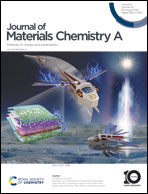Chinese dumpling-like NaTi2(PO4)3/MXene@reduced graphene oxide for capacitive deionization with high capacity and good cycling stability†
Abstract
Capacitive deionization (CDI) has emerged as a potential energy-efficient desalination technique to provide fresh water from brine, and the rational design of deionization electrodes remains a challenge. Cation insertion materials hold great potential in desalination and selective ion separation due to suitable space to intercalate cations; however, intrinsically low electrical conductivity and poor stability impede their further application in CDI. In this research, a partial in situ derivation tactic was proposed to address these problems by using Ti-based MXenes as metal precursors. The as-prepared NTP–MXene/rGO hybrid resembles the morphology of dumplings, where MXene/rGO serves as the skin to protect the NTP filling and enhance its electrical conductivity. This composite electrode material exhibited an outstanding salt adsorption capacity (SAC) of 251.55 mg g−1 in constant current mode with a specific current of 50 mA g−1 (cutoff voltage: 1.8 V; initial NaCl concentration: 10 mM), far higher than those of reported materials. Moreover, low energy consumption (0.19 kW h kgNaCl−1) was obtained at a cutoff voltage of 1 V, and stable cycling performance (approximately 80% capacity was retained after 100 cycles) makes M-NTP/rGO a suitable electrode for practical applications, proving that partial derivation is an attractive strategy in rational design of CDI electrodes.



 Please wait while we load your content...
Please wait while we load your content...